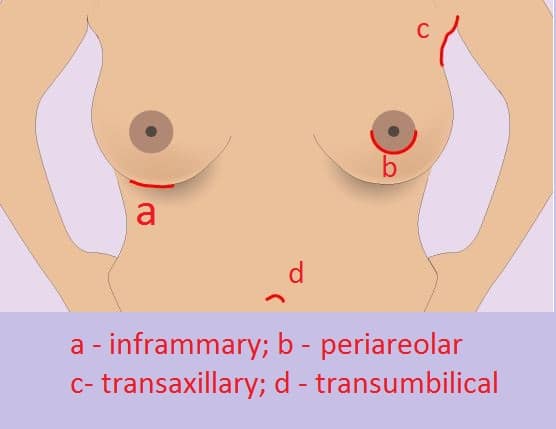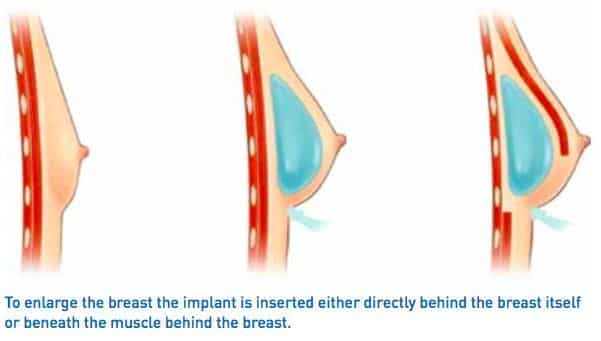Breast augmentation surgery is a plastic surgery procedure that is popularly known as “boob job”. The American Society of Plastic Surgeons (ASPS) note that in 2015, there were 279,143 breast augmentations procedures in the United States.
Essence of Breast of Breast Augmentation Surgery
Breast augmentation is a type of surgery that is carried for various non-cosmetic and cosmetics reasons.
The non-cosmetic reasons for a breast augmentation surgery include:
- to repair the wound sustained on the chest region after removal of breast cancer
- to correct birth defects of the breast
- to correct birth defects of the chest wall.
Breast augmentation surgery is carried out for cosmetic reasons as in:
- to increase the size of the breast
- to change the shape and
- to change the texture of the breast.
Read: Breast Reduction Surgery
A breast implant device is a medical prosthesis that is placed inside the breast to augment, reconstruct, or create the physical form of the breast.
There are three types of breast implant devices. They are classified base on the materials used for the filling.
- Saline Solution
This type of breast implant involves the use of filling with saline solution. Saline solution is physiological salt water that does not interfere with the normal functioning of the breast.
The solution is held within an elastomer silicone shell. These implants can be filled with different amounts of saline solution. This determines the feel, firmness, and shape of the breast.
- Silicone- Gel
This type of breast implant involves the use of filling with silicone gel. The silicone gel is filled inside an elastomer silicone shell.
There are concerns about a possible connection between silicone leaking into the body and the occurrence of connective-tissue and immune-related disorders such as scleroderma or rheumatoid arthritis but it has not been proved scientifically.
- Composite
This type of breast implant involves filling with miscellaneous composite materials such as soy oil, polypropylene string, etc. This has been proved to cause health risks and complications and as such their use have been banned in the United States and Europe.
Surgical Procedures for Breast Augmentation Surgery
A breast augmentation procedure involves the following steps:
1. Anesthesia
Medications are administered for the patient’s comfort. The choices of anesthesia include intravenous sedation and general anesthesia.
2. The Incision

breast augmentation incisions
The emplacement of a breast implant device is performed with five types of surgical incisions:
- Inframmary – This type of incision made below the breast and it allows for maxima access for precise dissection and emplacement of the breast implant material. This type of incision is preferred for emplacing silicone-gel implants but it can also produce thicker and more visible surgical scars.
- Periareolar – This type of incision is made along the border of the areolar. Its scars are less visible compare to that of inframmary incision but it can difficult to emplace the silicon-gel implant.
- Transaxillary – This type of incision is made to the axilla (armpit). The surgical scars as a result of transaxillary is less visible, however surgical revisions requires the use of Inframmary or periareolar incision.
- Transumbilical – is a less common implant-device insertion technique wherein the incision is at the navel.
- Transabdominal – the breast implants are tunneled superiorly from the abdominal incision into bluntly dissected implant pockets. During this procedure, the patient also undergoes abdominoplasty (tummy-tuck) at the same time.
3. Inserting and placing the breast implant

The procedure after the incision is made involves the insertion of a pocket either under the pectoral muscle or directly over the pectoral muscle.
The method for inserting and positioning breast implants depends on number of factors ranging from the type of implant, degree of enlargement desired, the patient’s body type and the surgeon’s recommendations.
4. Closing the incisions
The incision is closed using tissue unifying surgical devices as in sutures, stiches, surgical tapes and adhesives.
Recovery
At first the surgical incisions will be visible, however it fades with time. The surgical scars of breast augmentation heal at 6-weeks post-operative, and fade within several months, depending on the skin type of the woman
The woman may resume her normal life-activities about a week after the operation. The patient may also be giving medications such as pain pills to reduce pain and also antibiotics to prevent infections.
Medical Complications Following Breast Augmentation Surgery
Breast augmentation presents the same medical risks that are common to surgery. These include wound infection, fluid accumulation and post-operation bleeding.
Some of the medical complications that are more specific to breast augmentation surgery include:
– breast pain
– altered sensation
– thinning of breast tissue
– wrinkling
Breast Implant and Breast-feeding
A woman is able to breast-feed her infant after breast augmentation but there may be some cases of dysfunctional breastfeeding.
The magnitude of the dysfunction typically depends on the type of incision used for the procedure and the placement of the breast implant.
Periareolar incisions and placement of the breast implant directly on the pectoral muscle have greater incidences of breast-feeding difficulties.
Hence, it is advisable for women of child-bearing age to discuss their options with the surgeon prior to the operation


